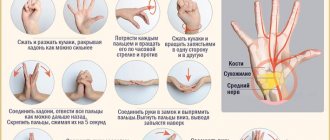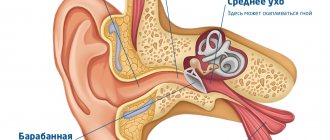Discomfort in the hands, which is accompanied by aching pain and tingling, is called numbness or paresthesia. The limbs become numb, their sensitivity disappears, and a tingling sensation or mild pain appears. These signs intensify during movement of the fingers, but after a short time they disappear, and the patient falls asleep again. According to medical statistics, about 45% of the population suffers from paresthesia at night. Everyone knows that numbness occurs due to disruption of blood flow. Then many patients have a question about why blood circulation is impaired.
Most people experience numbness in their hands at night due to an uncomfortable sleeping position. To get rid of unpleasant sensations, simply change your position. But if paresthesia occurs every night and does not disappear after the person changes position, then you should consult a doctor. Suspicious signs include numbness of only the right, left, or both limbs at once. And in some patients, an attack of paresthesia is accompanied by decreased vision. In such cases, you should visit a doctor who will conduct a diagnosis and identify the cause of the pathology. After all, paresthesia can be a sign of a dangerous disease.
External causes of hand numbness at night
Not all patients know why paresthesia occurs in the hands. Regular burning, tingling or crawling sensations at night can be caused by harmless reasons. One of them is an uncomfortable pillow. If the bedding is too high or you turn it over on your edge while sleeping, the spinal column bends in the neck area, which impedes the flow of blood. This can lead to discomfort, aching pain, and tingling. The easiest way to solve this problem is to just buy a comfortable flat or orthopedic pillow. On it, the spine assumes a normal position, in which all parts of the body are evenly supplied with blood.
Poor posture is another common cause of hand numbness during sleep. Many people fall asleep with their arm under their head or pillow, stretching their limbs above their heads, which compresses the blood vessels. At night, the work of all systems (including the circulatory system) slows down. Its power is not enough to supply blood to limbs that are in the wrong position.
Tight, inelastic clothing with rough seams or large fittings is not suitable for sleeping. It is recommended to give preference to a loose-fitting nightgown or pajamas made from natural fabric.
Paresthesia of the hands can occur due to the fact that a person does not remove jewelry before going to bed. Tight rings and bracelets can also interfere with blood flow.
The limbs become numb if a person’s work involves constant lifting of heavy objects to the level of the heart or above the head. Due to excessive physical activity during the day, blood circulation is disrupted and the sensitivity of the nerve roots decreases at night.
The likelihood of paresthesia increases if a person drinks alcohol or caffeinated drinks in the evening, which contribute to vasodilation. A similar reaction occurs after eating spicy food. Then, during sleep, the blood vessels narrow as much as possible, and the blood flow slows down.
A passive lifestyle, high load on the cervical spine while working at the computer, stress, and frequent hypothermia can also cause numbness in the hands during sleep.
These are the main causes of paresthesia of the limbs at night.
Symptoms
It is difficult to confuse a spasm with the manifestation of another disease. At the same time, convulsive muscle contractions vary in different cases, which helps to make a diagnosis.
Main features:
- strong muscle tension, manifestation of relief;
- lack of control over limbs;
- the hand is clenched into a fist or straightened as much as possible;
- sharp sharp or nagging pain;
- skin changes color (in case of poisoning);
- spasm gives way to relaxation, twitching occurs (with problems with the central nervous system).
Additional symptoms accompanying seizures are an indicator of a serious illness. If during an attack your vision darkens, your blood pressure rises, nausea and dizziness appear, then you have problems with the nervous system. With rare exceptions, this is associated with severe stress.
Diseases that cause numbness
There are more serious causes of numbness in the upper extremities that require timely treatment.
Carpal tunnel syndrome is a neurological disease that causes long-term pain and numbness in the fingers. Its main reason is constant tension in the tendons of the hands. The risk group includes office workers, musicians, seamstresses, etc. These people regularly perform the same type of limb movements throughout the day. In the wrist there is a thin channel with tendons and a nerve that is responsible for sensitivity in the fingers and also in the palm. In a healthy person, it is protected from negative factors, but if the hands are constantly tense, it becomes pinched and the tendon swells. Then the hand becomes numb at night (closer to the morning).
Important. Carpal tunnel syndrome should be treated as there is a possibility of the thumb muscles becoming smaller. As a result, the patient will not be able to perform simple movements.
The cause of numbness can be pathologies of the spinal column, during which blood circulation is disrupted. These diseases can manifest themselves as dizziness, cephalalgia (headache), periodic fainting, tinnitus, etc. If these symptoms are combined with numbness in the hands during sleep, then it is necessary to visit a doctor. This can manifest itself as cervical osteochondrosis or herniated intervertebral discs.
Numbness of the hands is characteristic of pathologies in which the lower cervical segments of the spine (C5 - C7) are damaged; it is from this area that the nerves responsible for the sensitivity of the upper extremities emerge. The localization of paresthesia depends on the nerve root:
- C7 – inner surface, from the shoulder to the tip of the little finger and half of the ring finger.
- C6 – back of the shoulder and forearm, back of the index and middle fingers.
- C5 - the side of the hand, the thumb, and also the index finger.
Osteochondrosis is the most common cause of hand numbness. During the pathology, the vertebrae are destroyed and the nerve roots of the spinal cord are pinched. Then paresthesia occurs at night, and sometimes during the day, the head often hurts, and the patient periodically loses consciousness. This condition requires proper treatment.
Your hands go numb when you sleep with vascular disorders. This is the most dangerous cause of paresthesia. If there is a violation of cerebral circulation, which is manifested by a sudden increase in pressure, vertigo (dizzy), confusion, numbness of the upper extremities, the likelihood of a micro-stroke increases. The disease occurs due to frequent stress, severe nervous tension, and a sharp increase in blood pressure.
Hands may become numb due to ischemic stroke (poor circulation, damage to brain tissue) of the cerebellar or vertebral artery. Pathology occurs due to difficulty or cessation of blood flow to a certain part of the brain. Then the patient becomes dizzy, hypertension occurs, and limbs go numb.
Reference. Smoking before bed provokes a sharp narrowing of the lumen of blood vessels, which increases the likelihood of hand paresthesia.
With polyarthritis of the small joints of the hands, only the fingers become numb. With diabetes mellitus and other diseases caused by metabolic disorders, a feeling of numbness occurs from distant parts, gradually rising upward. Then both upper limbs become numb.
Chronic pathologies can cause hand paresthesia:
- Arterial hypertension.
- Anemia.
- Multiple sclerosis.
- Deficiency of group B elements, as well as minerals.
- Rheumatoid arthritis.
- Vegetovascular dystonia.
- Cardiac ischemia (myocardial damage due to impaired blood supply).
- Raynaud's disease (excessive spasm of the arteries of the fingers after hypothermia or stress).
- Polyneuropathy (multiple damage to peripheral nerves).
- Thrombosis (blockage of blood vessels with a blood clot).
If paresthesia does not go away on its own within 60 minutes, then this is a good reason to seek medical help.
Types of seizures
All categories of people can experience seizures, regardless of age and lifestyle; they appear more often in the elderly and young children. Attacks are manifested by unequal painful muscle contractions and have different durations, mechanisms of development and frequency of occurrence. They are classified according to several criteria.
By locality
Depending on whether one muscle or a group of them is seized by a spasm, spasms are divided into:
- unilateral – when pain occurs on one side;
- focal (local) - appear in one muscle group;
- generalized - affect the whole body, causing involuntary urination, loss of consciousness and even respiratory arrest.
By duration of exposure
Classified into:
- myoclonic - short-term contractions or twitches, mainly in the upper part of the body, stop quickly and do not cause pain;
- clonic - characterized by a longer duration, muscles contract rhythmically, can be of a local or general type, sometimes contribute to stuttering;
- tonic – long-term, can occur in any part of the body, affect the respiratory tract, the part of the body seized by a convulsion takes one forced position, can lead to loss of consciousness;
- tonic-clonic - in which tonic spasms turn into clonic; if the second type predominates, they are called clono-tonic.
Paresthesia during pregnancy
The question of why paresthesia occurs in expectant mothers is quite relevant. During pregnancy, a woman’s hands also often go numb at night. This condition is provoked by the following reasons:
- Violation of water-salt metabolism.
- Magnesium or calcium deficiency.
- Damage to the vascular walls due to hormonal imbalance.
- Excessive weight gain.
- Uncomfortable position in sleep.
- Passive lifestyle.
- Diseases of the endocrine glands.
Expectant mothers may experience numbness in their limbs during sleep due to anemia and diseases of the spinal column, which are aggravated by increased body weight.
Numbness of the right hand
Symptoms of hand paresthesia vary: both limbs become numb or just one, some fingers go numb. This symptom may disappear immediately or last for several hours or days.
If the patient only has numbness in the right limb, this may indicate the following diseases:
- Vertebral pathologies (for example, cervical osteochondrosis or intervertebral hernia), which reduce the motor activity of the neck and forearms.
- Multiple sclerosis, in which cholesterol levels rise, blood pressure rises, and cerebral circulation is impaired.
- Right hand injuries.
In addition, the right limb becomes numb due to scoliosis and brachial plexitis (damage to the brachial nerve plexus).
Reference. Paresthesia of the right hand is not associated with heart pathologies. Sometimes this symptom may indicate an impending stroke, in which the blood vessels in the neck narrow.
Who to contact
Before going to the clinic, you should rule out all external causes of numbness. To do this, create conditions for a comfortable sleep: change the pillow and mattress, buy comfortable pajamas. If unpleasant signs do not disappear, then you need to consult a therapist. Blood tests will reveal the presence of high cholesterol. An electrocardiogram will show changes in the functioning of the heart.
You'll have to visit a neurologist's office. In addition to checking sensitivity, the doctor will examine an x-ray of the spine. In some cases, it is necessary to do a computed tomography scan of the cervical spine. Only on the basis of tests and examinations can an accurate diagnosis be made and treatment prescribed.
Numbness of the left hand
Persistent paresthesia of the left limb during sleep indicates heart disease.
The hand may become numb in the following cases:
- Before an attack of angina. The forearm and hand become numb; this symptom intensifies after physical activity. Chest pain appears.
- Atherosclerosis of the left brachial artery. The blood vessels narrow, blood circulation is impaired, and a tingling or “crawling” sensation appears in the left limb.
- Pre-infarction condition. In addition to numbness, dizziness, severe weakness, and sometimes chest pain occur.
- Pre-stroke condition. When the left hemisphere of the brain is diseased, the left limb goes numb, speech is impaired, vision deteriorates, and sometimes the left leg becomes numb.
- Thrombosis of the arteries of the left arm. The patient's limb sensitivity disappears, severe pain appears, and swelling appears in the affected area. If the pain does not disappear within 60 minutes, then the patient must be hospitalized immediately.
Paresthesia of the left limb occurs due to a lack of retinol and B vitamins; these substances are necessary to create the sheath of nerve fibers. With a deficiency of vitamins, the membrane is damaged, then the sensitivity of the nerve fibers decreases.
Reference. Numbness of the hands may indicate diseases of the nervous and circulatory systems, and sometimes brain pathologies. If the color of the fingers has changed to bluish or bright white, then the likelihood of Libman-Sachs disease (damage to connective tissue and blood vessels) or inflammation of the joints increases.
Diagnostics
The etiology of hand numbness is determined by a neurologist. In case of vascular pathology, consultation with a vascular surgeon is required. The specialist examines the history of the disease, assesses the condition of the limb, pulse in the arteries, identifies swelling, signs of inflammation, and other changes. A neurological examination includes the study of sensitivity, reflexes, and muscle strength. Based on the results, the following are assigned:
- Electrophysiological studies
. ENG, EMG, evoked potentials are carried out to differentiate damage to nerves, muscles and structures of the central nervous system, to clarify the location and degree of damage to the nerve trunk. - Radiography
. Performed for injuries, suspected compression of nerves by bone growths, neoplasms. Visualizes fractures, dislocations, osteophytes, bone deformities. - Vascular studies
. Informative for scalene muscle syndrome, Takayasu's disease, thromboangiitis obliterans. To determine the localization and severity of occlusion, vascular ultrasound, angiography, and aortography can be performed. - Other visualization techniques
. Computed tomography and magnetic resonance imaging are performed for diseases and traumatic injuries. Prescribed in case of ambiguous results of basic studies and planning of surgical interventions. - Lab tests
. Recommended for confirming the infectious and dysmetabolic genesis of polyneuropathies and diagnosing Takayasu’s disease.
Acupuncture
Danger of paresthesia
If night paresthesia continues for a long time, then this is an alarming sign. The consequences of this condition can be different:
- Chronic fatigue.
- Decreased ability to work.
- Potential for injury or death during potentially hazardous activities (driving a vehicle, operating a crane, operating an airplane, etc.).
- Tissue necrosis due to insufficient blood supply to a certain area of the body.
In addition, a person can die from dangerous diseases that are accompanied by numbness in the hands and other symptoms.
The question of what to do if there is frequent numbness in the limbs is quite relevant. You should seek medical help.
It is necessary to visit a doctor in the following cases:
- Hands go numb for a long time, at any time of the day, pain appears.
- Paresthesia interferes with work performance.
- Both limbs become numb.
- Numbness occurs suddenly and is accompanied by decreased visual acuity and mental disorders.
First, you need to consult with a therapist who will collect anamnesis and prescribe the necessary studies to identify the cause of the disorder. Then the doctor can refer the patient to a specialist (neurologist, cardiologist, etc.).
Massage
Massage helps to relax smooth muscles, as well as eliminate problems such as a pinched nerve. In this case, the action is aimed at the limbs and shoulder girdle, so the therapeutic effect will only appear if you do not have diseases of the internal organs.
It is better to seek help from a specialist to achieve quick results. At the same time, you can also do a massage at home that will relax your muscles.
Procedure:
- Using sliding movements, lightly touching the skin, carry out from the hand to the shoulder.
- Quickly rub the neck and shoulder girdle, avoiding strong pressure. Next, rub in a spiral, touching first with the inside of the palm and then with the edge. After active rubbing, they move on to slow stroking.
- Knead all the muscles from the hand to the shoulder, rhythmically pressing on the skin with the inside of the palm.
- Finish with light stroking of the limbs.
To achieve better results, rub ointments are used that have a warming effect. Pain-relieving ointments should not be used, as they do not improve blood flow to the hands.
Symptom elimination methods
If your limbs rarely go numb and only during sleep, then you should do the following:
- Buy a flat pillow and an orthopedic mattress. These bedding promote a comfortable body position and allow you to sleep soundly.
- Avoid tight nightgowns or pajamas, and make sure there are no rough seams on your sleepwear.
- Try to sleep on your back with your arms extended along your body.
If you have followed all the rules, and your limbs continue to become numb, then you should go to the hospital. To determine the true causes of paresthesia, you need to undergo an MRI, electrocardiography, and laboratory blood tests. After this, the identified pathology should be treated. Some patients will have to change their occupation.
You can get rid of numbness using the following methods:
- Laser or ultrasound therapy. These procedures help normalize blood supply and saturate the affected tissues with useful substances. Electrophoresis is used to deliver medications to the affected area. Magnetic therapy and paraffin therapy are also used to treat the causes of paresthesia.
- Manual therapy is used to eliminate inflammatory processes that cause numbness in the hands during sleep. This technique allows you to get rid of oxygen starvation of blood vessels.
- Exercise therapy helps strengthen muscles, ligaments, normalize blood circulation and lymphatic drainage of the upper extremities. After the therapeutic course, it is recommended to maintain moderate physical activity to avoid relapse.
Reference. To treat nocturnal paresthesia of the hands, the patient is prescribed vitamin supplements, massage, and medications that dilate blood vessels and relieve inflammation. The doctor may recommend alternative treatments: reflexology (acupuncture), hirudotherapy (treatment with medicinal leeches).
Therapeutic exercises can be used to treat and prevent numbness of the upper extremities:
- Place your palms together. Rub your hands vigorously against each other for 2 minutes.
- Place your palms together, then simultaneously clench your fists with your left and right hands.
- Press your palms together, cross your fingers, squeeze and unclench them.
- Place your hand on the table so that your hand hangs down, then raise and lower it.
- Touch with all fingers of the thumb, while the thumb remains motionless.
The patient can also massage each finger of the right hand of the left (from base to tip), and then repeat the procedure for the left limb.
Local treatment will help restore mobility, as well as sensitivity of damaged tissues, and improve the condition of blood vessels. After the therapeutic course, discomfort disappears and the likelihood of dangerous complications decreases.
Folk remedies
Traditional medicine will help fight numbness in the hands. For this purpose, external and internal means are used:
- Contrast baths. Place your hands alternately in cold and then in hot water. Then rub them with a towel, put on warm cotton gloves at night.
- Medicine to strengthen blood vessels. Grind 1 kg of parsley, celery, 2 lemons using a blender or meat grinder. Combine the resulting mixture with 250 ml of honey, mix thoroughly. Use the product 3 tbsp. spoons in the morning on an empty stomach.
- Pumpkin compress. Peel, chop 300 g of pumpkin, boil until tender. Then knead, apply the mixture to the limbs, cover with cling film on top, and insulate with a woolen scarf or scarf. Remove the compress when the mixture has cooled. Then go to bed.
- Grinding of red pepper and cucumbers. Grind a few pickled cucumbers, mix them with red pepper ground in a blender. Fill the mixture with vodka, transfer to a glass container, cover with a lid, and place in a dark place for a week. Then filter the liquid through cheesecloth and rub the brushes.
- Ledum tincture. Mix pharmacy tincture of wild rosemary with natural apple cider vinegar in a ratio of 1:3, leave for a week. Then rub the liquid into your hands.
- Decoction bath. Pour 1 liter of water 1 tbsp. a spoonful of birch buds, oak bark or aspen. Bring to a boil, reduce heat, simmer for another 3 minutes. Then remove and strain. Pour the liquid into a container, soak your hands for 30 minutes, then rub them, warm them with gloves. To achieve the best effect, perform 15 sessions.
Reference. Folk remedies will give good results only as part of complex therapy. Before using them, you should obtain permission from your doctor.
Preventive measures
To prevent paresthesia of the arms, the muscles that hold the intervertebral discs should be strengthened. To do this, you should perform special gymnastics, the progress of which should be monitored by a doctor.
To prevent numbness of the upper extremities, the patient must follow the following rules:
- Do not wear a heavy backpack or shoulder bag for a long time.
- Do not sit for a long time with your arm resting on the back of a chair or armchair.
- Monitor your position during sedentary work, avoid activities during which you need to raise your limbs for a long time to the level of your heart or above your head.
- While working at the computer, periodically perform the above-described hand exercises.
- Force yourself to lie down in a horizontal position with your arms outstretched and rest for at least 5 minutes three times a day.
- Replenish your diet with fish, seafood, nuts, and seeds.
Numbness of the hands at night is an unpleasant phenomenon that requires attention. If you find out that paresthesia is not caused by external factors, then you should immediately consult a doctor who will find out the cause of the disorder. Do not delay going to the hospital, as this symptom may indicate dangerous pathologies that threaten life. To avoid paresthesia, you should maintain moderate physical activity, give up bad habits, eat right, and avoid prolonged lifting of heavy objects.
Proper nutrition
Tasty and healthy are two different things, so the diet is often rich in foods that are poor in vitamins and microelements. The problem is especially acute in winter and early spring, which can cause spasms in the hands or other parts of the body.
Since cramps are provoked by a lack of calcium, potassium, magnesium, the following products are introduced into the diet:
- milk;
- natural kefir;
- carrot;
- beets;
- apples;
- dried apricots;
- rice bran;
- nuts (hazelnuts, walnuts, peanuts).
Products that contain a record amount of vitamins:
- A - duck liver;
- B1 - pistachios;
- B2 - pine nuts;
- B3 - beef liver;
- B4 - chicken eggs;
- B6 - pine nuts;
- B8 - sprouted wheat;
- B9 - peanuts;
- B12 - fried beef liver;
- C - rose hips;
- D - mackerel;
- E - wheat germ oil;
- R - lemon zest;
- PP - peanuts.
Eliminate from your diet foods that worsen the condition or remove vitamins and minerals:
- alcohol;
- coffee;
- strong tea;
- cocoa;
- extra dark chocolate.
Nutrition should be complete so that you do not lack proteins or carbohydrates. To do this, regularly consume soups, cereals, as well as fresh vegetables and herbs.










